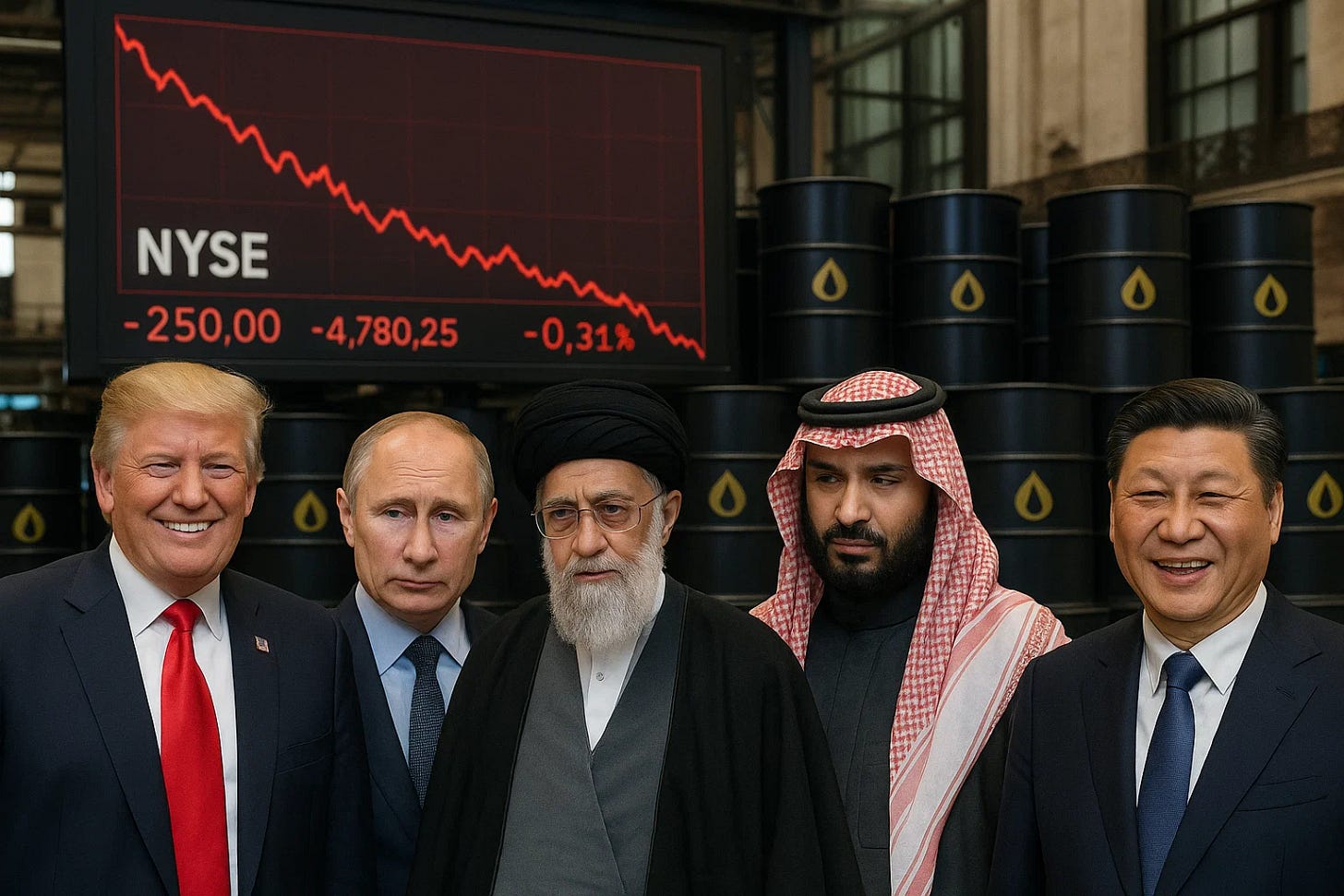Oil Price Ceiling Forms Above Inventories & Spare Capacity While "Peace" Dividend Returns
Espresso Briefing #7: Key oil market developments this week, short and sharp like your morning espresso.
4 min read
Market Summary
Tension Decline: The Israel–Iran ceasefire has erased much of the geopolitical risk premium, sending oil prices down ~12%—a reminder that structural supply still dominates.
Persistent Supply Cushion: Despite the flare-up in the Middle East, ample global supply—especially from U.S. shale and OPEC+ continues to drive a surplus environment.
EV & Efficiency Drag: Accelerating electric vehicle adoption and efficiency gains are tempering demand growth, especially in China and OECD economies.
Refining Margins Up: Shutdowns and outages in the U.S. and Europe have boosted refining margins to ~$8.4/bbl—the strongest since early 2024.
🛢 Supply
Global Overview: IEA data show world supply reached ~104.6 Mb/d in May, projected to rise ~1.6 Mb/d through 2025—led by non-OPEC+ output, especially U.S. shale and Middle East projects.
OPEC+ & Iran: OPEC+ continues to roll back cuts, increasing output this year. Iran's production remains resilient (~4.7 Mb/d in 2024), though sanctions and diplomatic shifts bring uncertainty.
Geopolitical Risks: Iran’s Strait of Hormuz threats have raised shipping and insurance costs—doubling tanker premiums since mid-June—but no actual flow disruption so far.
Implications: Market overhang remains. Sufficient unencumbered capacity and pipeline alternatives (e.g., Saudi East‑West, UAE bypass routes) blunt the impact of geopolitical threats.
🔍 Demand
Global Picture: IEA projects demand growth of ~740 kb/d in 2025, tapering to ~760 kb/d in 2026. But OECD demand is shrinking (‑120 kb/d in 2025), underscoring the role of non-OECD growth.
China’s Plateau: Nearly half of new car sales are electric; oil demand in China is expected to plateau or peak by 2027–2029.
U.S. & Global EV Impact: OECD declines are partially offset by modest demand gains in the U.S., yet EVs continue to chip away at gasoline and diesel consumption.
Implications: Demand growth is becoming bifurcated: weak in developed markets, flat to moderate in developing. Structural headwinds from EV penetration and energy efficiency challenge upside in oil consumption.
📦 Inventories
Onshore Storage: ~3.13 billion barrels stored in onshore facilities globally, the highest since the pandemic, driven largely by China
Crude in floating storage: ~74 million barrels, marking a two‑year high as of mid‑June.
Refined products in floating storage: ~86 million barrels—also a pandemic-era high.
Oil “in-transit” is growing as voyage times lengthen, especially due to some Red Sea rerouting, though exact recent volumes aren't publicly disclosed.
Implications: Overall crude inventories remain bloated, but product-specific tightness is supporting refinery margins. That said, limited room for price recovery until crude drawdowns happen.
🏭 Refining
Global Throughput: Forecasts place global refinery throughput near ~83.2 Mb/d for 2025, rising modestly in 2026. Many older or expensive plants have shuttered in U.S./Europe.
Profit Margins: Margins have climbed to ~$8.37/bbl—the highest since Mar 2024—driven by outages and capacity rationalization.
Regional Divergence: Europe benefits most from diesel tightness, with margins surging ~30% recently; U.S. and Asia lag behind.
Implications: While refined-product margins are healthy short-term, long-term demand erosion from EVs and regulation could undercut economics. Refineries must leverage high margins while they last, accelerating efficiency and conversion investments.
🌍 Geopolitical & Regional Developments
Ceasefire Effect: The Israel–Iran ceasefire has removed much immediate risk premium, leading to a steep fall in Brent and WTI. Traders now see this as a temporary reprieve.
Strait of Hormuz Politics: Iran’s Parliament debated closure, raising shipping costs—but the Supreme Council stopped short. Iran lacks alternatives to substituting this economic risk.
Iran’s Gasoline Crisis: Domestic shortages (~15–20% shortfall) have triggered panic buying, but no real export disruption…yet. Iran is importing to fill gaps, including using barter deals.
Implications: Geopolitics may create episodic ripple effects (e.g., insurance costs, inventory draws), but broad fundamentals (supply overhang, weak demand) continue to hold sway. Iranian domestic issues have limited global footprint—publishable rather than pivotal.
📅 Upcoming Events
IEA June Oil Market Report (released ~July 11) will update monthly supply/demand balances.
OPEC+ Strategy Dialogue expected later this summer—watch for incremental output signals.
OECD meetings (30 June–3 July) may bring revisions to demand forecasts and inventory snapshots.
✅ Bottom Line
The current “peace dividend” may offer a short-lived rally in product margins—but without a deeper drawdown in crude markets or demand resurgence, oil prices look range-bound in the $60–80/bbl band.





